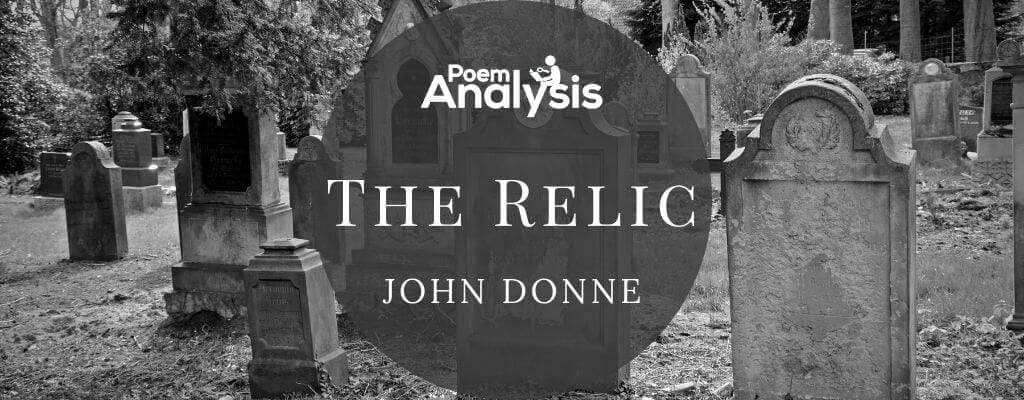‘The Relic’ by John Donne is a three-stanza poem that is made up of sets of eleven lines. The form of the stanzas, as well as the rhyming pattern of the lines, is quite interesting. A reader will immediately see the varied indention of the lines, but with closer inspection, the rhyme scheme becomes clear as well.
The poem follows a pattern of aabbcddceee. Additionally, the meter is somewhat hard to determine. This is due to the fact that while most lines are written in iambic pentameter, there are a number of exceptions. The poem is told from the perspective of a first-person narrator. This person brings an otherworldly, but still relatable, tone to the text.
The Relic John DonneWhen my grave is broke up again Some second guest to entertain, (For graves have learn'd that woman head, To be to more than one a bed) And he that digs it, spiesA bracelet of bright hair about the bone, Will he not let'us alone,And think that there a loving couple lies,Who thought that this device might be some wayTo make their souls, at the last busy day,Meet at this grave, and make a little stay?If this fall in a time, or land, Where mis-devotion doth command, Then he, that digs us up, will bring Us to the bishop, and the king, To make us relics; thenThou shalt be a Mary Magdalen, and I A something else thereby;All women shall adore us, and some men;And since at such time miracles are sought,I would have that age by this paper taughtWhat miracles we harmless lovers wrought.First, we lov'd well and faithfully, Yet knew not what we lov'd, nor why; Difference of sex no more we knew Than our guardian angels do; Coming and going, wePerchance might kiss, but not between those meals; Our hands ne'er touch'd the sealsWhich nature, injur'd by late law, sets free;These miracles we did, but now alas,All measure, and all language, I should pass,Should I tell what a miracle she was.
Summary of The Relic
The poem begins with the speaker proposing a future in which his remains, alongside a bracelet of hair, are interpreted as evidence of a miracle. In this future world, the speaker tells of how men making the discovery take the find to a king or bishop. The speaker and his lover would then be made into saints to be worship by men and women.
The speaker laughs over this possibility, dismissing these kinds of crafted miracles. He turns instead to the nature of their relationship as a real example of a miracle. They loved one another, mostly from afar, only sharing a few kisses here and there. While the speaker might want more to happen between them, he understands the importance of their spiritual connection.
Analysis of The Relic
Stanza One
When my grave is broke up again
Some second guest to entertain,
(For graves have learn’d that woman head,
To be to more than one a bed)
And he that digs it, spies
A bracelet of bright hair about the bone,
Will he not let’us alone,
And think that there a loving couple lies,
Who thought that this device might be some way
To make their souls, at the last busy day,
Meet at this grave, and make a little stay?
In the first stanza of ‘The Relic’, the speaker proposes a possible future scenario. It is not one that he particularly wants to come to pass, but is a situation he can see happening. He sets the scene by imagining that he takes a piece of hair from his lover. Before he dies, he winds this around his wrist like a bracelet. The man is buried that way. He remains at peace until his “grave is broke up again. ” This refers to the dirt that covers him being dug up and a “second guest,” or another body buried there.
This event is meant to happen sometime in the far future when his own remains would be mostly decomposed. For whatever reason, these gravediggers did not expect to find a body. After doing so, they notice the “bracelet of bright hair about the bone” of his wrist. Unlike the rest of the body, it has not decomposed at all. This is a testament to the regard in which the speaker holds his lover. She has some kind of otherworldly power that transcends time, or at least this representation of her does.
The stanza continues on to describe the part of this proposed narrative that the speaker finds amusing. It is likely, he believes, that these grave diggers will look on the hair around his wrist and make up a story about it. Perhaps they will believe that the man wore “this device… / To make their souls… / Meet at this grave, and make a little stay.” They propose that the hair worked some kind of magic to reunite them. This is a humorous possibility to the speaker who knows he would never attempt something like this, nor does he seem to believe it would ever work. The speaker is passing judgement on superstition and crafted, magic thinking.
Stanza Two
If this fall in a time, or land,
Where mis-devotion doth command,
Then he, that digs us up, will bring
Us to the bishop, and the king,
To make us relics; then
Thou shalt be a Mary Magdalen, and I
A something else thereby;
All women shall adore us, and some men;
And since at such time miracles are sought,
I would have that age by this paper taught
What miracles we harmless lovers wrought.
The story continues into the second stanza where it sets out the possibilities for what comes next. The person who found the speaker’s decaying body will “bring / Us to the bishop” or to the king. One of these two will understand the crafted importance behind the find and “make us relics” He speaks to the listener with humour in his voice. This is not something he longs for, rather something he wants to make fun of. He sees their position in the eyes of the world being raised to the like of “Mary Magdalen.”
In the last four lines, which are more structured than those which come before them, speak on how “All…shall adore us.” Mostly women will be devoted to these two new saints, but probably some men too. The lines speak of the future as a time in which “miracles” are actively “sought” out. He hopes that with “this paper” he will have “taught” the future of the true miracles the “lovers wrought.”
Stanza Three
First, we lov’d well and faithfully,
Yet knew not what we lov’d, nor why;
Difference of sex no more we knew
Than our guardian angels do;
Coming and going, we
Perchance might kiss, but not between those meals;
Our hands ne’er touch’d the seals
Which nature, injur’d by late law, sets free;
These miracles we did, but now alas,
All measure, and all language, I should pass,
Should I tell what a miracle she was.
In the last lines of ‘The Relic’, he describes what he sees as being the truly magical parts of his relationship. He and his listener have “lov’d well and faithfully.” Their love was transcendent in that there was no clear reason why they loved one another, the relationship just existed. The two operated around one another as simple bodies. There was no difference in sex, as exist within other relationships. They felt for one another as “guardian angels” feel for their charges: a love without qualification.
The next lines reveal that the relationship has not progressed farther than a “kiss.” They come and go around one another and in passing touch. The speaker seems at least slightly annoyed that the relationship has not progressed farther than this. They have not come close enough to “touch…the seals / Which nature…sets free.”
Although he might wish there was physically more between them, but he appreciates the miracle-like nature of the love they do share. But more than that, it is the woman herself who appears to him as a miracle. This relates back to his previous statements about the truth of miracles and the amount of importance one should place on them. “miracles” that can be described, such as the hair around his future wrist, is worth nothing. In contrast, he is unable to articulate the intensity of the spiritual connection between himself and the lover. This categorizes it as a true miracle.





“It is likely, he believes, that this grave differs will look on the hair around his wrist and make up a story about it. Perhaps they will believe…”
Please correct to “that these grave diggers”.
Many thanks for the explication.
Done. Thank you!
Thanks Emma. Clear and succinct. I find Donne’s poetry very convoluted and riddling. Glad for your elucidation.
On Emma’s behalf – thank you for your kind words.
Thanks emma
On her behalf – you’re welcome.